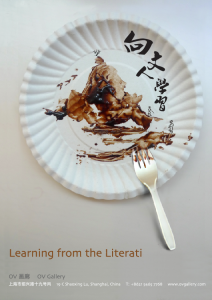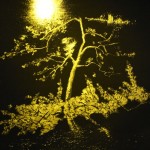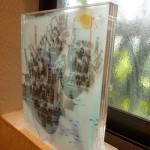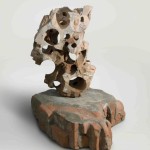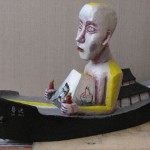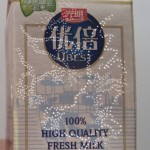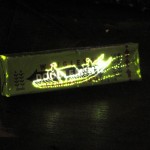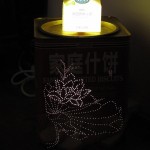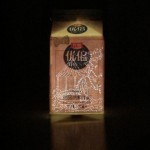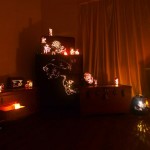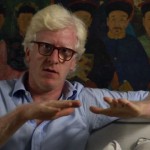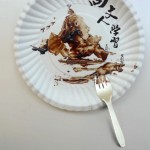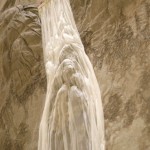Chen Hangfeng: Winds Blow from the West: Orchid, Cut plastic shopping bags, pins, wood board, mini fans, timer, transformer, power source, 60 x 80 (cm), 2010
“The Manual of the Mustard Seed Garden” is a well-known model for the study of Chinese painting. I chose plum blossoms, orchids, bamboo and chrysanthemums as templates. The ancient artists used ink, but I use plastic shopping bags, which are cut into small pieces and pinned onto a wooden board. The drawings are based on a series of illustrations meant to teach amateurs how to draw these plants. A row of mini fans is mounted on the side of the piece, causing a periodic rustling of the plastic pieces, yet when the timer goes off and the fans stop blowing, the pieces always return to their original positions.
Plastic shopping bags have almost become a necessity of modern life, and the reflective surface is seemingly cheap. It explores the phenomenon of people blindly pursuing Chinese traditional culture and literati spirit on a surface level – something which has become a consumer trend. Here, nailing pieces onto the board symbolizes how this culture has already become a specimen or artifact. The wind caused by the fans seems to bring the plants to life. In addition, the artificial wind blows mostly from the left side, or the west, symbolizing how traditional Chinese cultural values are affected by Western civilization. Because of this, the original or indigenous becomes even more valuable – after the wind stops, the plants return to their original shape.
Gao Mingyan: Glittering Space, mixed media, LED lights, dimensions variable, 2010
The furniture and household items I use in this work are all from the gaige kaifang or Reform and Opening Up period (after ‘79). At that time, China was in a stage of rapid development, but it was an awkward period for art and culture. The cultural legacy left by China’s Ming and Qing Dynasties collided with the European cultural influence that had begun to have an impact on China; the two cultures then blended and formed another new culture; this phenomenon became more and more prevalent and was later referred to as “haipai.”
Haipai culture is rooted in traditional Chinese culture, the cultures of the Wu and Yue civilizations in the South and elements of China’s other regional cultures. It has also absorbed elements of Western culture, combining all of these elements to create a new, unique personality.
This time, I am using dots of light to display the techniques of the masters of Chinese landscape paintings and now I’ve created a modern way to show ancient Chinese paintings. While this may seem awkward, they nonetheless attempt to uphold a spirit of beauty.
I chose to paint on these everyday items after discovering that some early literati wrote poems and created artworks on all kinds of household goods without any restrictions on the medium. Although these household goods became priceless artworks for future generations, the literati were not vain – their painting on household items was a mere expression of their boundless freedom and their devil may care attitudes.
Girolamo Marri: What I did learn from the literati? , 3-Video Installation on a loop, Dimensions Variable, 2010
In my understanding, a brief definition of a literati artist could be“A charismatic artist inspired by nature; a political, philosophical and aesthetical leader in his community.”
I asked myself whether it would be possible to become something similar nowadays, and I based this work on a completely negative answer.
In the context of a show where so much is based on the beauty of nature and harmonious life, I am quite happy to present a disruptive element. My big face unpleasantly shows up among trees and waterfalls, and shouts that, no matter how much we romantically delude ourselves, we have in reality succeeded in building a society where nature and art are almost useless.
Ji Wenyu Zhu Weibing: Feat of Humanity, linen, gauze and other materials, 606 x 88 x 15 (cm), 2010
The work “Feat of Humanity” 2010 takes the form of a traditional landscape scroll painting. There is a small person sitting in a huge landscape who is looking at a hydropower station between the mountains and the waterfall. There are many things in nature that fill people with awe and pride, leading them to believe that they themselves are great and invincible. Today’s nature is not the same as the nature we see in traditional Chinese paintings. It has been transformed by humans. Do we still remember the awe-inspiring nature that existed in the past?
Now, the noises of modern society are forcing people to concern themselves with an alternative form of quiet reflection. This peacefulness is not the quiet serenity of the past, but is the settling of the dust after a momentous disturbance. This is not true peace, but only a noisy shadow of tranquility.
Qian Rong: Lu Xun Boat, sculpture, resin and acrylic, 70 x 43 x 21 (cm), 2010
“Learning from the Literati” is a sentence well-phrased – the key here is “learning” something. Literati, or so-called intellectuals, should have their own, independent character and spirit and be capable of independent thinking. The ships in this work represent ideas of sailing, navigation and transportation. Any day on the Huangpu River one can see a great variety of vessels. Living in Shanghai, one sees these sights every day, however it still surprises and shocks me every time a ship, big or small, passes by. The images of pagodas, houses and intellectuals represent tradition. These elements combine with eachother to broker a transition from old to new and to attempt to connect the past, the present and the future. The result is sometimes absurd and forces viewers to think. Literati ideas can be seen as a candle, bringing us a light that guides our path into the future.
In these works, I give the characters calm, unwavering eyes and robust bodies; they are pursuing ideals of simplicity and eternal contemplation. The colors are taken from reality, but also maintain some distance from reality, which gives the viewer room for reflection.
Shi Jinsong: Beifu No. 525, bricks and cement, dimensions variable, 2010
A play named “The Falling Peach Blossoms,” was staged here last year, everything which used to be alive (peaches and good wine) will be gone in time, leaving only a dry well and wretched walls. The artist has gathered some cement blocks from this ruinous heap, then chiseled some holes to allow the wind to swirl in and out through the holes, as if the rock is breathing. In order to make the shape resemble rock from Tai Lake, he polishes the surface of the stone to a shine, so it looks as if it has been touched by many hands – in the end the result is a new kind of beauty and grace. If we see a beautiful vision, does it matter in whose courtyard we see it?
